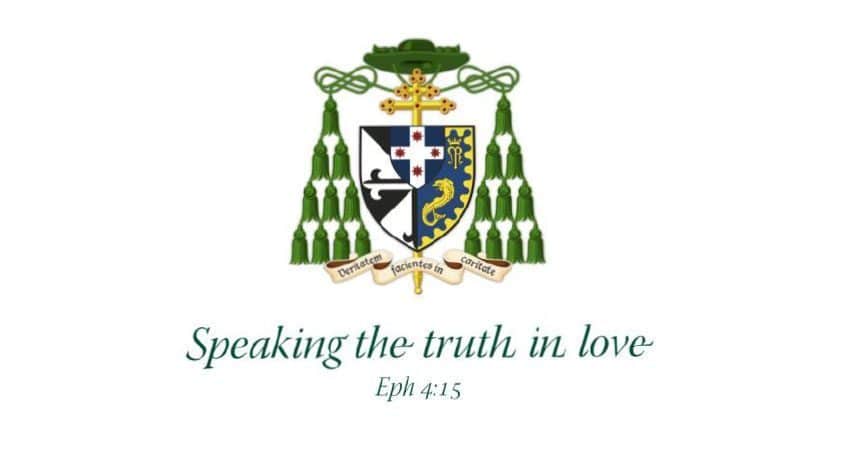HOMILY FOR MASS OF THE 25TH SUNDAY OF ORDINARY TIME YEAR B

Live-streamed from St. Mary’s Basilica, Sydney, 19 September 2021
The 19th century Russian playwright, Anton Chekhov, was also an important contributor to the evolution of the short story. His principle, known as ‘Chekov’s Gun’, forbade including elements that are not going to be ‘paid off’ later in the story. “If in the first act you have hung a pistol on the wall,” he wrote, “then in the following one it should be fired. Otherwise don’t put it there.”[1] Given how little space there is in a short story, every detail must count. St Mark, the short story writer of the New Testament, followed a similar rule, dispensing with many of the healings and teachings reported by the other three evangelists and offering slimmed down versions of the stories they tell in common.
Peter’s hometown of Capernaum, for example, is mentioned 16 times in the Gospels. It is associated with family and forgiveness, fasting and worship, exorcisms and healings, with prophecy and cursing, with the crowd pursuing Jesus across the lake in boats and Jesus crossing the same water without one.[2] It’s a busy Gospel place. But Mark mentions it only three times: at the beginning of the Gospel, when Jesus and His first four disciples “went to Capernaum; and when the Sabbath came, he entered the synagogue and taught. And all were astounded at his teaching, for he taught as one having real authority.” (Mk 1:21-22) A few verses later we’re told “after some days he returned to Capernaum, which he had made his base” and there He healed many (Mk 2:1). We have the ‘loaded gun’, so to speak.
Seven chapters later (Mk 9:30-37), Mark ‘fires the gun’. The team, which now includes twelve apostles and some women (Mk 3:13-19; 15:41), are again on their way to Capernaum. But they are bickering. Not about the mystery of the incarnation by which their mate Jesus is also Son of God (Mk 8:27; 9:2-8). Not about His death and resurrection, which He has just prophesied (Mk 8:31-3; 9:30-2). No, rather than crucial questions of Christian doctrine, identity and mission, their focus is on who is the greatest. As St James observes, disharmony comes from jealousy, ambition, the desire always to get one’s own way (Jas 3:16-4:3).
But in Mark’s Gospel we know that Capernaum is the place of instruction, where Jesus taught with authority, and the place of homecoming and healing, where He was at ease with His relatives, friends and clients. So He sits down to teach them another lesson: “If you really want to be first, put yourself last… Among the Gentiles the rulers lord it over them… but it must not be so among you. Whoever wishes to be great among you must be the servant… like the Son of Man, who came to serve, not to be served.”[3] The gun has fired.
“What were you arguing about together on the road?” the Lord asks. In Greek “together on the road” is syn-odos σύνοδος (synodos), from which we get our word synod. In the lead-up to the Fifth Plenary Council of Australia, there’s been a lot of talk about the failures of some past Church leaders and the exercise of power self-servingly, unaccountably, even harmfully—as the Royal Commission pointed out. We must find better ways of exercising authority together and well.
But should we throw the ecclesial baby out with the bath water? The Second Vatican Council confirmed the ancient faith that the Church is the whole People of God and that the hierarchical structure that serves them is divinely ordained (Lumen Gentium chs II & III). Assuming secular accounts of power and aping secular modes of governance, some would reduce the role of pastors to the ceremonial, while leaving Church governance to boards of lay experts. But such proposals are at odds with Catholic faith (CCC 874-96 etc.). As today’s Gospel highlights, however imperfect they might be, Christ’s troop has ‘the Twelve’ at its heart: ours is essentially an apostolic or episcopal Church.
What’s more, structures are for mission, not vice versa. If we are not sure what our purpose is, how can a model of governance be judged ‘fit for purpose’? The task of a Plenary Council is to reflect upon the gifts and challenges of the day and prayerfully discern the best pastoral approaches. If we are clear-sighted about the mission—to “welcome the Son and the One who sent Him”—then needed structural changes will become apparent.
Clearly, it is important that there be wide consultation of the laity; that many voices be heard; that co-responsibility be recognised and authority shared; that people’s expertise be deployed; that sclerotic processes be fixed; and that we conceive of the Church in collaborative, collegial, synodal terms as Pope Francis asks.
We are well down that road already. Lay women have always determined the course of the Church, above all by having children (or not) and by transmitting the faith to them (or not). But if the parish church and school are people’s principal meeting points for most people with the Church, they usually encounter a man as pastor of the one and a lay woman as principal of the other. In this archdiocese, most departments and agencies are headed either by lay men[4] or more often by lay women.[5] There are lay women and men on the formation team and council of the seminary, our curia and diocesan committees, as board members or leaders of our parish councils and ministries, schools and universities, hospitals and aged care, social services and chaplaincies, religious institutes, movements and PJPs. Other lay people have of their own initiative established their own excellent ministries. In recent years women have been national directors of Catholic education, health and social services, echoing the lead formerly given by women religious. Granted, much of this is under-appreciated. But even as we make great strides in this area, we must be wary of creating new power elites and a new lay version of clericalism. No more squabbling over power, Jesus says, for Christians authority is about service not control.
Indeed, looking beyond Mark’s Capernaum, we see in John’s Gospel that it was at Capernaum that some of the disciples left Jesus because His teachings on the Eucharist were so hard (Jn 6:60-66). The other two Gospels also record that Jesus was exasperated by Capernaum’s lack of faith (Mt 11:23; Lk 10:15). Ultimately, we either assent to Christ’s teachings and make our home in His Church or we stop walking together and take another course. To remain we must embrace Him with the enthusiasm of children.
In 587 AD, with the connivance of the Byzantine Emperor Maurice, Archbishop John IV of Constantinople, John IV, assumed the title ‘Ecumenical Patriarch’ or father of the civilised world. In response, Pope Gregory I called himself Servus servorum Dei, servant of the servants of God. Great popes ever since have preferred this title—certainty Pope Francis does.[6] It suggests an inverted pyramid, with God and humanity at the top (so to speak), served by the People of God ‘below’ them; with the People of God served by deacons and priests ‘beneath’ them; the priests and people served in turn by bishops, archbishops and cardinals ‘under’ them; and with all these servants of God served by the successor of Peter at the ‘bottom’ of the hierarchy or ‘lowrarchy’. It is not the way the world sees things. But if we focus on our mission as servants of God, we can be confident that, by God’s grace, we will have the right servant-leaders going forward. For this we pray.
[1] From I. Ya. Gurlyand, ‘Reminiscences of A. P. Chekhov’, in Teatr i iskusstvo 28 (11 July 1904), p. 521.
[2] Mt 4:13-17; 8:5-27; 11:20-24; 17:24-18:35; Mk 1:21-39; 2:1-3:6; 9:30-49; Lk 4:23,31-41; 5:17-26; 7:1-10; 10:13-16; Jn 2:12; 4:46; 6:24.
[3] Mk 9:35; cf. Mk 10:42-45; Mt 12:18-19; Lk 12:37; 17:7-10; Jn 12:26; Phil 2:6-7.
[4] E.g. the Chancellor and the Executive Director Administration & Finance, the directors of the Anti-Slavery Taskforce, CatholicCare, the Catholic Development Fund, the Catholic Weekly, the Charitable Works Fund and other Fundraising, Confraternity of Christian Doctrine, the Life, Marriage and Family Office, Retired Priests’ Care, Sydney Catholic Schools, Sydney Catholic Youth, the Sydney Centre for Evangelisation, and University Chaplaincies.
[5] E.g. the Directors of Aboriginal Catholic Ministry, Archives, Caritas Sydney, Catholic Institute of Sydney, Child Protection and Safeguarding Office, (Vicar for) Consecrated Life, Early Childhood Services, Ecumenism and Interfaith Office, Ephpheta Centre for Deaf, Legal Counsel, Parish Renewal Team, and the Public Affairs & Engagement.
[6] E.g. Pope Francis, Interview en route from America, 29 September 2015: “I’m not a pop star: I’m servant of the servants of God”; Angelus, 4 November 2014; Homily for Mass at Santa Marta, 11 November 2014; Homily for Mass for Deceased Cardinals and Bishops, 3 November 2015; Angelus, 6 March 2016; Homily for Mass at Santa Marta, 8 November 2016; Angelus, 17 September 2017; Homily for Mass of Holy Thursday at Velletri Prison, 18 April 2019; General Audience, 24 April 2019; Homily for Mass at Santa Marta, 8 November 2019; Angelus, 19 July 2020 etc.
A warm welcome to St Mary’s Basilica, the cathedral church of Sydney, for this livestreamed Solemn Mass of the 25th Sunday of Ordinary Time. As the Church in Australia approaches the forthcoming Plenary Council, we listen especially intently to the Spirit speaking to the Church in the Word of God. That our ears might be opened, we first repent of anything that make us resistant to hearing that “still quiet voice”, especially our sins…

